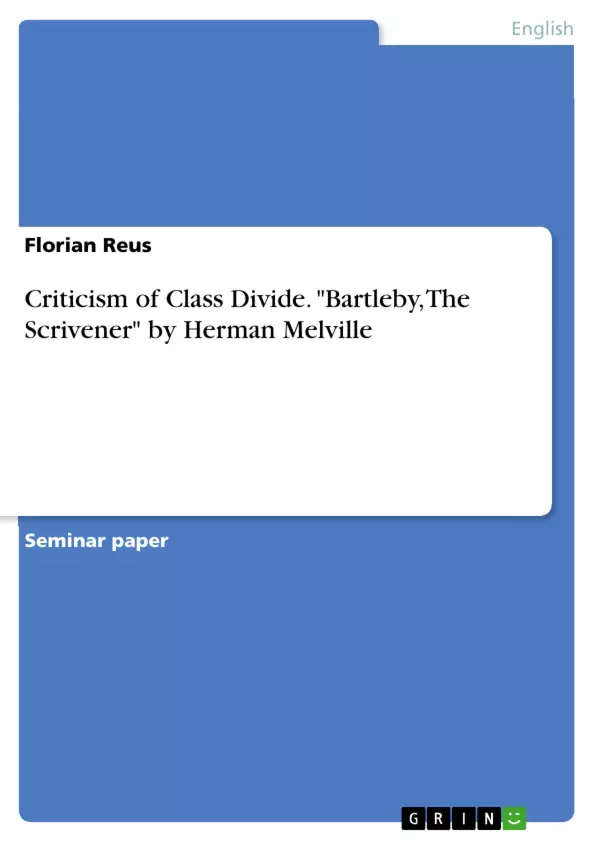In Melville's short story "Bartleby, the Scrivener", the reader is presented with a very visual example of this growing divide. It tells the story of a successful lawyer and one of his scriveners, Bartleby. From the beginning, the two have a strained relationship marked by misunderstanding and isolation from one another. This isolation leads to the famed preference of Bartleby to not do certain tasks and results in a growing and ultimately fatal conflict between these two main protagonists.
The Industrial Revolution undoubtedly changed humanity forever and not only revolutionized the way we produce and sell goods but also reformed social structures and dismantled long-established principles of hierarchy and class. In preindustrial times, one's position in society was mostly predetermined by birth, both physically and economically. Wealth and power were almost exclusively inherited and there was practically no social mobility. However, this changed with the advent of industrialization, as there was a new rising class in society: The capitalists.
Unlike other social classes that existed until then, capitalists where not created by birth, but rather by economic success. The possibility of social mobility and that birth did, in fact, not determine your success in life, was promising for many. This promise sparked many new concepts of society and equality, one of the most famous being the term of the "American Dream". However, this idealistic imagination of capitalism was soon to be disproven, as the growing divide between the two classes, workers and capitalists, became to appear insuperable.
Inhaltsverzeichnis (Table of Contents)
- Introduction
- The Relevance of Space and Separation as criticism of class divide in Herman Melville's „Bartleby, the Scrivener”
- I. Historical context
- II. Space and separation as symbols for class divide
- Conclusion
Zielsetzung und Themenschwerpunkte (Objectives and Key Themes)
This paper examines Herman Melville's short story "Bartleby, the Scrivener" as a critique of the growing class divide in 19th-century New York. The paper analyzes how the story uses space and separation as symbols to represent the separation and conflict between the upper and lower classes. It explores the historical context of the story, particularly the Astor Place Riots, and relates those events to the characters and themes within the narrative.
- Class divide in 19th-century New York
- Space and separation as symbols of social inequality
- The historical context of the Astor Place Riots
- The character of Bartleby as a representative of the working class
- The lawyer as a representation of the upper class and the economic elite
Zusammenfassung der Kapitel (Chapter Summaries)
- Introduction: This chapter introduces the concept of class divide in 19th-century New York, highlighting the impact of the Industrial Revolution and the rise of capitalism. It introduces the central characters of the story: the lawyer and Bartleby, and establishes the strained relationship between them.
- I. Historical Context: This chapter discusses the historical context of the story, focusing on the Astor Place Riots of 1849, a class-based conflict in New York. It links these events to the narrative and provides insight into the social climate surrounding the story.
- II. Space and Separation as symbols for class divide: This chapter focuses on the use of space and separation as symbols of class divide in the story. It analyzes how the physical separation between characters, like the "ground glass folding doors" and the screen between the lawyer and Bartleby, represent the social and economic distance between the classes.
Schlüsselwörter (Keywords)
This paper focuses on the themes of class divide, social mobility, space and separation, and the historical context of 19th-century New York, specifically the Astor Place Riots. It explores the use of symbolism in Herman Melville's "Bartleby, the Scrivener" to critique the social and economic inequalities of the time.
- Arbeit zitieren
- Florian Reus (Autor:in), 2018, Criticism of Class Divide. "Bartleby, The Scrivener" by Herman Melville, München, GRIN Verlag, https://www.hausarbeiten.de/document/1348474


